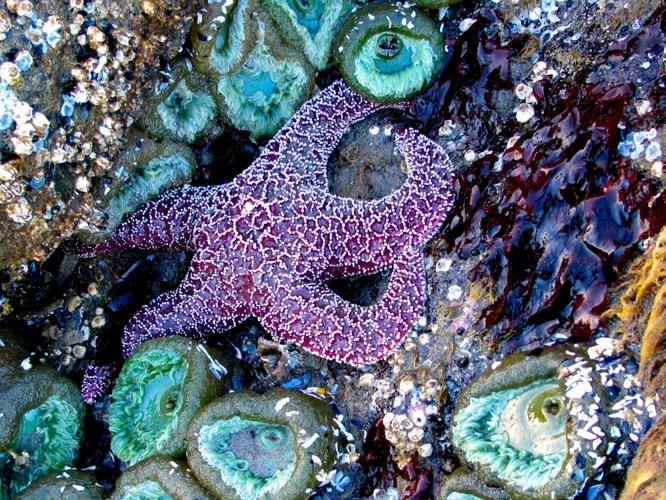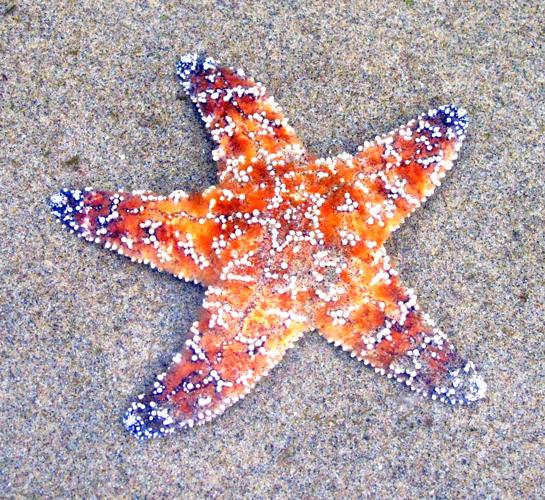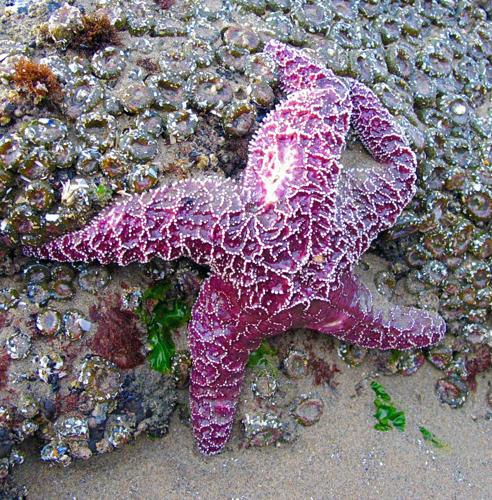Considered the signature species of the Pacific tide pool, Pisaster ochraceus reigns over the intertidal zone, clinging to every rocky shore from Alaska all the way to Panama.
Known more commonly as the ochre sea star or purple starfish, this five-rayed favorite is actually not a fish at all, but belongs instead to a unique class of animals called echinoderms, meaning “spiny-skinned,” and includes other nautical celebrities like the sand dollar, sea cucumber and sea urchin.
Aside from its characteristic deep purple, this sea star is also found in shades of red, orange, brown or yellow, with some individuals displaying a mix of colors. One of the longest-living stars to inhabit the ocean, it can grow to a diameter of up to 18 inches and will survive in an ideal climate for almost 20 years.
Lacking blood (not to mention a brain), it lives by pumping seawater through a complex vascular system, engaging its own lymphatic processes to continually adjust the chemistry of the water — a technique that remains one of the beautiful mysteries of sea star biology.
A voracious predator, with two stomachs and a special taste for bivalves, Pisaster’s eating habits seem like they belong to a B-grade horror monster: Secreting a glue-like substance from the tubed feet that cover its underside, it cements its rays to the shell of its victim, forcibly prying it apart. Then it regurgitates its own stomach, shooting it inside the trapped creature, where it releases a digestive enzyme that quickly turns its prey into a kind of liquefied soup. Strong ligaments then help pull the stomach back into the sea star, where the delectable fluid becomes available for the second stage of digestion.
Strangely enough, it is precisely these unruly table manners that have secured Pisaster’s place as a keystone species of the ocean environment: When its insatiable appetite is allowed to keep other species in check, the entire ecosystem thrives with diversity.
Beginning in 2013, sea star populations up and down the Pacific coast began to experience massive die-offs, with stars contracting a terrible virus-related illness known as sea star wasting syndrome. The disease, present in the environment since at least the 1970s, causes lesions, then a decay of bodily tissues, followed by full disintegration and, finally, death. Similar die-offs have occurred in the past, but never with such magnitude or geographic breadth.
In 2015, an incredible surge in the populations of juvenile sea stars created hope for a rebound, but sadly, celebrations of the stars’ recovery were premature: Today, more than 20 species of sea stars, including the beloved Pisaster ochraceus, continue to die from the disease, and at a rate that has researchers and scientists rather alarmed. A 2016 study linked the widespread disease, which has dropped Pacific Northwest sea star populations by 75 percent overall, to the warming of the ocean caused by human-induced climate change.
In our local tide pools, where the colorful stars once flourished by the hundreds, populations have dwindled to just a few. To learn more about them, including how you might help their plight by becoming a citizen-scientist, visit seastarwasting.org, or join the excellent team efforts of the Haystack Rock Awareness Program in Cannon Beach.




(0) comments
Welcome to the discussion.
Log In
Keep it Clean. Please avoid obscene, vulgar, lewd, racist or sexually-oriented language.
PLEASE TURN OFF YOUR CAPS LOCK.
Don't Threaten. Threats of harming another person will not be tolerated.
Be Truthful. Don't knowingly lie about anyone or anything.
Be Nice. No racism, sexism or any sort of -ism that is degrading to another person.
Be Proactive. Use the 'Report' link on each comment to let us know of abusive posts.
Share with Us. We'd love to hear eyewitness accounts, the history behind an article.